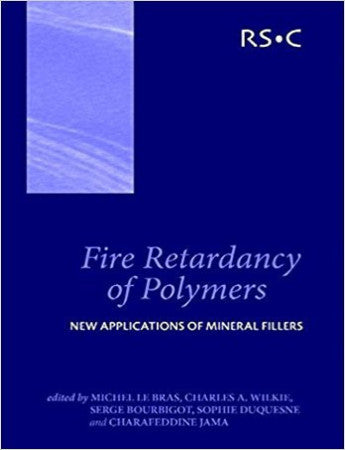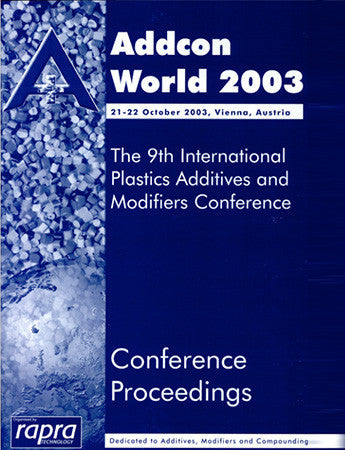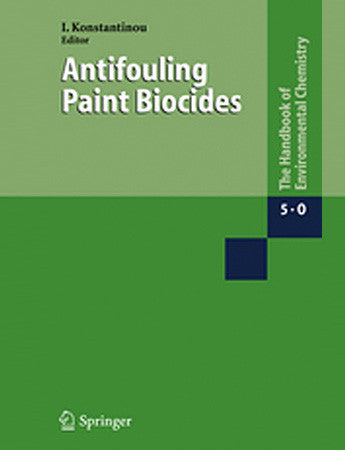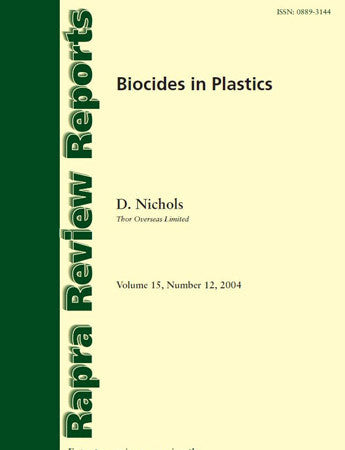Fire Retardancy of Polymers
The use of polymers is restricted by their flammability- they may indeed initiate or propagate fire. Fire Retardancy of Polymers focuses on mineral additives from either micro- or nano-composites for application in fire retardants. With the use of fire retardant additives containing halogen or phosphorus compounds in decline, the need for other systems is evident.
The major materials that are used as fire retardant fillers for polymers are alumina trihydrate or magnesium hydroxide, which account for more than 50% by weight of the worldwide sales of fire retardants. Recent works have shown that such halogen-free compounds may give enhanced fire retardancy to polymeric materials when used in low levels, alone, or in the synergistic mixture and that the corresponding fire performances depend on the dispersion of the mineral filler, micrometer-scale dispersion leading to the best performances.
Specialists discuss these new applications of mineral fillers with particular emphasis on action mechanisms, new materials including textiles, toxicology, and hazards. With extensive references, this book provides a comprehensive and up-to-date view of these applications and will appeal to professionals, materials scientists, and engineers looking for novel ways to eliminate fire hazards and improve flame retardancy of materials, with a special interest in sustainable development.
The major materials that are used as fire retardant fillers for polymers are alumina trihydrate or magnesium hydroxide, which account for more than 50% by weight of the worldwide sales of fire retardants. Recent works have shown that such halogen-free compounds may give enhanced fire retardancy to polymeric materials when used in low levels, alone, or in the synergistic mixture and that the corresponding fire performances depend on the dispersion of the mineral filler, micrometer-scale dispersion leading to the best performances.
Specialists discuss these new applications of mineral fillers with particular emphasis on action mechanisms, new materials including textiles, toxicology, and hazards. With extensive references, this book provides a comprehensive and up-to-date view of these applications and will appeal to professionals, materials scientists, and engineers looking for novel ways to eliminate fire hazards and improve flame retardancy of materials, with a special interest in sustainable development.
Related Products
Addcon World 2003
$195.00
{"id":11242247108,"title":"Addcon World 2003","handle":"978-1-85957-370-9","description":"\u003ch5\u003eDescription\u003c\/h5\u003e\nAuthor: Conference Proceedings \u003cbr\u003eISBN 978-1-85957-370-9 \u003cbr\u003e\u003cbr\u003eVienna, Austria, 21-22 October 2003\u003cbr\u003e\u003cbr\u003epages 243\u003cbr\u003e\n\u003ch5\u003eSummary\u003c\/h5\u003e\nAddcon World 2003 was the 9th international conference on additives for plastics. The two-day conference focused on the technical advances and issues facing the plastics additives and modifiers industry. Papers consider value creation in the additives business and various aspects of additive technology, including flame retardants, stabilisers, process aids, compatibilisers, impact modifiers, and new pigments\n\u003ch5\u003eTable of Contents\u003c\/h5\u003e\nList of Papers \u003cbr\u003e\u003cbr\u003e\u003cstrong\u003eSESSION ONE - ADDITIVE MARKET TRENDS\u003c\/strong\u003e \u003cbr\u003eMarkets for Plastics Additives\u003cbr\u003eGeoff Pritchard, Hallow Plastics\/Rapra, UK Plastics Additives Market in China\u003cbr\u003eRobert Constable, Fred Gastrock \u0026amp; Louis Kattas, BRG Townsend Inc, USA End Users and Additives Suppliers: Where are the Fields of Understanding and Mutual Value Creation?\u003cbr\u003eRaphael Mestanza, SpecialChem, France \u003cbr\u003e\u003cstrong\u003eSESSION TWO - COMPATIBILISERS\/ FORMULATION SOFTWARE\u003c\/strong\u003e \u003cbr\u003eCompatibilisation of Polypropylene\/Polystyrene Blends by Aromatic-Grafted Polypropylene\u003cbr\u003eSyed Mustafa Syed Jamaludin, R Nor Azlan, MY Ahmad Fuad, ZA Mohd Ishak \u0026amp; H Azanam Shah, SIRIM Berhad, Malaysia Modeling and Informatics for the Development of Additives and Formulations\u003cbr\u003eDavid Nicolaides, Gerhard Goldbeck-Wood, Klaus Stark \u0026amp; Antoine Schlijper, Accelrys, UK \u003cbr\u003e\u003cstrong\u003eSESSION THREE - FLAME RETARDANTS AND MODIFIERS\u003c\/strong\u003e \u003cbr\u003eNew Developments in Flame Retarded PBT\u003cbr\u003e2Ronald Wilmer, 2Rudi Borms, 1Yoav Bar Yaakov \u0026amp; 1Pierre Georlette, DSBG Eurobrom BV, 1 Israel, 2The Netherlands Studies on the Mechanism of Thermal Decomposition of Unsaturates Polyester Resins with Reduced Flammability\u003cbr\u003eEwa Kicko-Walczak, Industrial Chemistry Research Institute, Poland A New MBS Impact Modifier for Tailor-Made ABS\u003cbr\u003eDidier Debier, Fabrizio Trinchero, Rohm \u0026amp; Haas France SAS, France Functionalised Ethylene Acrylate Polymers as Polymer Modifiers\u003cbr\u003eKarlheinz Hausmann, Richard T Chou \u0026amp; Coreen Y Lee, DuPont de Nemours International SA, Switzerland \u003cbr\u003e\u003cstrong\u003eSESSION FOUR - PROTECTING PLASTICS\u003c\/strong\u003e \u003cbr\u003eEnvironmental and Micro-Environmental Influences Affecting Performance of Polymer Stabilisers\u003cbr\u003e1Jan Pospí?il, 1Jan Pilar, 1Antonín Marek, 2Norman C. Billingham, 1Zdenek Horák \u0026amp; 1Stanislav Ne?purek, 1Inst of Macromolecular Chemistry, Czech Republic \u0026amp; 2Sussex University, UK Hindered Benzoates and HALS: High Performance Combinations for Polyolefin Light Stabilisation\u003cbr\u003eVincenzo Malatesta, L Davis, I Vulic, J Eng \u0026amp; G Vitarelli, Cytec Industries, USA Responding to the Consumers Desire for Improved Hygiene with Antibacterial Plastics\u003cbr\u003eJohn Payne, Avecia Protection and Hygiene, UK Liquid Stabilisers ? New Approach to Address Current and Future Issues Facing PVC\u003cbr\u003eC Carraz, Akcros Chemicals, UK \u003cbr\u003e\u003cstrong\u003eSESSION FIVE -PROCESS AIDS\/PACKAGING\u003c\/strong\u003e \u003cbr\u003ePolymer Processing Additives: New Products and New Applications\u003cbr\u003ePatrizia Brasioli, Dyneon GmbH \u0026amp; Co KG, Italy Evaluation of Performance of Additives Used in Linear Low Density Polyethylene (LLDPE) Films for Active Packaging Applications\u003cbr\u003eVivek Kale, Kalpesh Jani, R Rangaprasad \u0026amp; Yatish Vasudeo, Reliance Industries Ltd, India Improved Antiblocks for High Clarity Polyethylene Film\u003cbr\u003e1Daniel Swartz \u0026amp; 2Daniel Davidson, 1Eagle-Picher Minerals Inc \u0026amp; 2Plastiscience LLC, USA Additive Masterbatches to Promote Biodegradability in Polymers\u003cbr\u003eAndrew Barclay, Wells Plastics Ltd, UK \u003cbr\u003e\u003cstrong\u003eSESSION SIX - PIGMENTS AND CARBON BLACKS\u003c\/strong\u003e \u003cbr\u003eNovel Pigment Preparations\u003cbr\u003eMichael Bauer \u0026amp; Martin Kunz, Inprotec Inc, Germany Weld Lines? What Weld Lines? Getting Better Appearance From Metallic Pigmented Mouldings\u003cbr\u003eIan Wheeler, Silberline Ltd, UK Conductive Carbon Blacks for Plastics Applications\u003cbr\u003eChristine Van Bellingen, Nicolas Probst \u0026amp; Eusebiu Grivei, Erachem Comilog SA, Belgium\u003cstrong\u003e \u003cbr\u003eSESSION SEVEN - NANO-PARTICLES AND FILLERS\u003c\/strong\u003e \u003cbr\u003ePolymer Nanocomposites: A New Additive Concept for Polymer Materials\u003cbr\u003eThomas Engelhardt, Sud-Chemie AG, Germany Synthesis of Organically-Modified Silica Particles for use as Fillers in Polymer Systems\u003cbr\u003eAnna Arkhireeva \u0026amp; John Hay, Surrey University, UK New Formulations for Syndiotactic Polystyrene\u003cbr\u003eEwa Kowalska, W Skupinski \u0026amp; Z Wielgosz, Industrial Chemistry Research Institute, Poland Carbon Nanofibres for Innovative Masterbatch Applications\u003cbr\u003eAndreas Eder, Gabriel-Chemie, Austria\u003cbr\u003e\u003cbr\u003e","published_at":"2017-06-22T21:15:05-04:00","created_at":"2017-06-22T21:15:05-04:00","vendor":"Chemtec Publishing","type":"Book","tags":["2003","book","compatibilisers","flame retardants","impact modifiers","p-additives","pigments","plastic","polymer","process aids","stabilisers"],"price":19500,"price_min":19500,"price_max":19500,"available":true,"price_varies":false,"compare_at_price":null,"compare_at_price_min":0,"compare_at_price_max":0,"compare_at_price_varies":false,"variants":[{"id":43378461892,"title":"Default Title","option1":"Default Title","option2":null,"option3":null,"sku":"","requires_shipping":true,"taxable":true,"featured_image":null,"available":true,"name":"Addcon World 2003","public_title":null,"options":["Default Title"],"price":19500,"weight":1000,"compare_at_price":null,"inventory_quantity":1,"inventory_management":null,"inventory_policy":"continue","barcode":"978-1-85957-370-9","requires_selling_plan":false,"selling_plan_allocations":[]}],"images":["\/\/chemtec.org\/cdn\/shop\/products\/978-1-85957-370-9.jpg?v=1499136429"],"featured_image":"\/\/chemtec.org\/cdn\/shop\/products\/978-1-85957-370-9.jpg?v=1499136429","options":["Title"],"media":[{"alt":null,"id":353503543389,"position":1,"preview_image":{"aspect_ratio":0.767,"height":450,"width":345,"src":"\/\/chemtec.org\/cdn\/shop\/products\/978-1-85957-370-9.jpg?v=1499136429"},"aspect_ratio":0.767,"height":450,"media_type":"image","src":"\/\/chemtec.org\/cdn\/shop\/products\/978-1-85957-370-9.jpg?v=1499136429","width":345}],"requires_selling_plan":false,"selling_plan_groups":[],"content":"\u003ch5\u003eDescription\u003c\/h5\u003e\nAuthor: Conference Proceedings \u003cbr\u003eISBN 978-1-85957-370-9 \u003cbr\u003e\u003cbr\u003eVienna, Austria, 21-22 October 2003\u003cbr\u003e\u003cbr\u003epages 243\u003cbr\u003e\n\u003ch5\u003eSummary\u003c\/h5\u003e\nAddcon World 2003 was the 9th international conference on additives for plastics. The two-day conference focused on the technical advances and issues facing the plastics additives and modifiers industry. Papers consider value creation in the additives business and various aspects of additive technology, including flame retardants, stabilisers, process aids, compatibilisers, impact modifiers, and new pigments\n\u003ch5\u003eTable of Contents\u003c\/h5\u003e\nList of Papers \u003cbr\u003e\u003cbr\u003e\u003cstrong\u003eSESSION ONE - ADDITIVE MARKET TRENDS\u003c\/strong\u003e \u003cbr\u003eMarkets for Plastics Additives\u003cbr\u003eGeoff Pritchard, Hallow Plastics\/Rapra, UK Plastics Additives Market in China\u003cbr\u003eRobert Constable, Fred Gastrock \u0026amp; Louis Kattas, BRG Townsend Inc, USA End Users and Additives Suppliers: Where are the Fields of Understanding and Mutual Value Creation?\u003cbr\u003eRaphael Mestanza, SpecialChem, France \u003cbr\u003e\u003cstrong\u003eSESSION TWO - COMPATIBILISERS\/ FORMULATION SOFTWARE\u003c\/strong\u003e \u003cbr\u003eCompatibilisation of Polypropylene\/Polystyrene Blends by Aromatic-Grafted Polypropylene\u003cbr\u003eSyed Mustafa Syed Jamaludin, R Nor Azlan, MY Ahmad Fuad, ZA Mohd Ishak \u0026amp; H Azanam Shah, SIRIM Berhad, Malaysia Modeling and Informatics for the Development of Additives and Formulations\u003cbr\u003eDavid Nicolaides, Gerhard Goldbeck-Wood, Klaus Stark \u0026amp; Antoine Schlijper, Accelrys, UK \u003cbr\u003e\u003cstrong\u003eSESSION THREE - FLAME RETARDANTS AND MODIFIERS\u003c\/strong\u003e \u003cbr\u003eNew Developments in Flame Retarded PBT\u003cbr\u003e2Ronald Wilmer, 2Rudi Borms, 1Yoav Bar Yaakov \u0026amp; 1Pierre Georlette, DSBG Eurobrom BV, 1 Israel, 2The Netherlands Studies on the Mechanism of Thermal Decomposition of Unsaturates Polyester Resins with Reduced Flammability\u003cbr\u003eEwa Kicko-Walczak, Industrial Chemistry Research Institute, Poland A New MBS Impact Modifier for Tailor-Made ABS\u003cbr\u003eDidier Debier, Fabrizio Trinchero, Rohm \u0026amp; Haas France SAS, France Functionalised Ethylene Acrylate Polymers as Polymer Modifiers\u003cbr\u003eKarlheinz Hausmann, Richard T Chou \u0026amp; Coreen Y Lee, DuPont de Nemours International SA, Switzerland \u003cbr\u003e\u003cstrong\u003eSESSION FOUR - PROTECTING PLASTICS\u003c\/strong\u003e \u003cbr\u003eEnvironmental and Micro-Environmental Influences Affecting Performance of Polymer Stabilisers\u003cbr\u003e1Jan Pospí?il, 1Jan Pilar, 1Antonín Marek, 2Norman C. Billingham, 1Zdenek Horák \u0026amp; 1Stanislav Ne?purek, 1Inst of Macromolecular Chemistry, Czech Republic \u0026amp; 2Sussex University, UK Hindered Benzoates and HALS: High Performance Combinations for Polyolefin Light Stabilisation\u003cbr\u003eVincenzo Malatesta, L Davis, I Vulic, J Eng \u0026amp; G Vitarelli, Cytec Industries, USA Responding to the Consumers Desire for Improved Hygiene with Antibacterial Plastics\u003cbr\u003eJohn Payne, Avecia Protection and Hygiene, UK Liquid Stabilisers ? New Approach to Address Current and Future Issues Facing PVC\u003cbr\u003eC Carraz, Akcros Chemicals, UK \u003cbr\u003e\u003cstrong\u003eSESSION FIVE -PROCESS AIDS\/PACKAGING\u003c\/strong\u003e \u003cbr\u003ePolymer Processing Additives: New Products and New Applications\u003cbr\u003ePatrizia Brasioli, Dyneon GmbH \u0026amp; Co KG, Italy Evaluation of Performance of Additives Used in Linear Low Density Polyethylene (LLDPE) Films for Active Packaging Applications\u003cbr\u003eVivek Kale, Kalpesh Jani, R Rangaprasad \u0026amp; Yatish Vasudeo, Reliance Industries Ltd, India Improved Antiblocks for High Clarity Polyethylene Film\u003cbr\u003e1Daniel Swartz \u0026amp; 2Daniel Davidson, 1Eagle-Picher Minerals Inc \u0026amp; 2Plastiscience LLC, USA Additive Masterbatches to Promote Biodegradability in Polymers\u003cbr\u003eAndrew Barclay, Wells Plastics Ltd, UK \u003cbr\u003e\u003cstrong\u003eSESSION SIX - PIGMENTS AND CARBON BLACKS\u003c\/strong\u003e \u003cbr\u003eNovel Pigment Preparations\u003cbr\u003eMichael Bauer \u0026amp; Martin Kunz, Inprotec Inc, Germany Weld Lines? What Weld Lines? Getting Better Appearance From Metallic Pigmented Mouldings\u003cbr\u003eIan Wheeler, Silberline Ltd, UK Conductive Carbon Blacks for Plastics Applications\u003cbr\u003eChristine Van Bellingen, Nicolas Probst \u0026amp; Eusebiu Grivei, Erachem Comilog SA, Belgium\u003cstrong\u003e \u003cbr\u003eSESSION SEVEN - NANO-PARTICLES AND FILLERS\u003c\/strong\u003e \u003cbr\u003ePolymer Nanocomposites: A New Additive Concept for Polymer Materials\u003cbr\u003eThomas Engelhardt, Sud-Chemie AG, Germany Synthesis of Organically-Modified Silica Particles for use as Fillers in Polymer Systems\u003cbr\u003eAnna Arkhireeva \u0026amp; John Hay, Surrey University, UK New Formulations for Syndiotactic Polystyrene\u003cbr\u003eEwa Kowalska, W Skupinski \u0026amp; Z Wielgosz, Industrial Chemistry Research Institute, Poland Carbon Nanofibres for Innovative Masterbatch Applications\u003cbr\u003eAndreas Eder, Gabriel-Chemie, Austria\u003cbr\u003e\u003cbr\u003e"}
Antifouling Paint Bioc...
$330.00
{"id":11242246724,"title":"Antifouling Paint Biocides","handle":"978-3-540-31404-2","description":"\u003ch5\u003eDescription\u003c\/h5\u003e\nAuthor: Konstantinou, Ioannis K. (Ed.) \u003cbr\u003eISBN 978-3-540-31404-2 \u003cbr\u003e\u003cbr\u003e\n\u003cp\u003e266 p., Hardcover\u003c\/p\u003e\n\u003cp\u003eThis item usually ships in 3-4 weeks.\u003c\/p\u003e\n\u003ch5\u003eSummary\u003c\/h5\u003e\nThis volume describes the state-of-the-art advances regarding antifouling paint biocides and provides a thorough evaluation of research and information on major topics such as occurrence and levels, environmental fate, analytical techniques and methods for the monitoring and control, environmental modeling, ecotoxicological effects and risk assessment placing emphasis on the knowledge acquired over the last 10 years. The contamination of the aquatic environment by antifouling compounds has been a topic of increasing importance during the last few years.\u003cbr\u003eThe major classes of antifouling active biocides are discussed including the old-fashioned organotin compounds, the modern organic booster biocides and the promising naturally occurring antifoulant products. Therefore, the reader will get a balanced view of this developing field. Chapters were written by leading experts in their field who critically surveyed all the major areas of progress. This volume is an important resource and can constitute a good grounding in the field of antifouling paint biocides.\u003cbr\u003e\u003cbr\u003e\n\u003ch5\u003eTable of Contents\u003c\/h5\u003e\nJ.W. Readman: Development, Occurrence, and Regulation of Antifouling Paint Biocides: Historical Review and Future Trends.- I. Omae: Chemistry and Fate of Organotin Antifouling Biocides in the Environment.- C. Brunori, I. Ipolyi, P. Massanisso, R. Morabito: New Trends in Sample Preparation Methods for the Determination of Organotin Compounds in Marine Matrices.- K. Fent: Worldwide Occurrence and Effects of Organotin Antifouling Paints in the Aquatic Environment.- B. van Hattum, A. Baart, J. Boon: Emission Estimation and Chemical Fate Modelling of Antifoulants.- A. Aguera, M.D. Hernado, A. Fernandez-Alba, D. Barcelo: Evaluation of Antifouling Booster Biocides in Marine Water and Sediments based on Mass Spectrometric Techniques.- N. Voulvoulis: Antifouling Paint Booster Biocides: Occurrence and Partitioning in Water and Sediments.- V.A. Sakkas, I.K. Konstantinou, T.A. Albanis: Photochemical Fate of Organic Booster Biocides in the Aquatic Environment.- H. Okamura, H. Mieno: Present Status of the Antifouling Systems in Japan: TBT Substitutes in Japan.- H. Yamada: Toxicity and Preliminary Risk Assessment of Alternative Antifouling Biocides to Aquatic Organisms.- I. Omae: General Aspects of Natural Products Antifoulants in the Environment","published_at":"2017-06-22T21:15:04-04:00","created_at":"2017-06-22T21:15:04-04:00","vendor":"Chemtec Publishing","type":"Book","tags":["2006","antifouling agents","Biocides","biostabilizer","Biostabilizers","book","organotin compounds","p-additives","Paint","polymer","TBT","Tertiary Butyl Tin","water pollution"],"price":33000,"price_min":33000,"price_max":33000,"available":true,"price_varies":false,"compare_at_price":null,"compare_at_price_min":0,"compare_at_price_max":0,"compare_at_price_varies":false,"variants":[{"id":43378458500,"title":"Default Title","option1":"Default Title","option2":null,"option3":null,"sku":"","requires_shipping":true,"taxable":true,"featured_image":null,"available":true,"name":"Antifouling Paint Biocides","public_title":null,"options":["Default Title"],"price":33000,"weight":1000,"compare_at_price":null,"inventory_quantity":1,"inventory_management":null,"inventory_policy":"continue","barcode":"978-3-540-31404-2","requires_selling_plan":false,"selling_plan_allocations":[]}],"images":["\/\/chemtec.org\/cdn\/shop\/products\/978-3-540-31404-2.jpg?v=1498187278"],"featured_image":"\/\/chemtec.org\/cdn\/shop\/products\/978-3-540-31404-2.jpg?v=1498187278","options":["Title"],"media":[{"alt":null,"id":350148264029,"position":1,"preview_image":{"aspect_ratio":0.767,"height":450,"width":345,"src":"\/\/chemtec.org\/cdn\/shop\/products\/978-3-540-31404-2.jpg?v=1498187278"},"aspect_ratio":0.767,"height":450,"media_type":"image","src":"\/\/chemtec.org\/cdn\/shop\/products\/978-3-540-31404-2.jpg?v=1498187278","width":345}],"requires_selling_plan":false,"selling_plan_groups":[],"content":"\u003ch5\u003eDescription\u003c\/h5\u003e\nAuthor: Konstantinou, Ioannis K. (Ed.) \u003cbr\u003eISBN 978-3-540-31404-2 \u003cbr\u003e\u003cbr\u003e\n\u003cp\u003e266 p., Hardcover\u003c\/p\u003e\n\u003cp\u003eThis item usually ships in 3-4 weeks.\u003c\/p\u003e\n\u003ch5\u003eSummary\u003c\/h5\u003e\nThis volume describes the state-of-the-art advances regarding antifouling paint biocides and provides a thorough evaluation of research and information on major topics such as occurrence and levels, environmental fate, analytical techniques and methods for the monitoring and control, environmental modeling, ecotoxicological effects and risk assessment placing emphasis on the knowledge acquired over the last 10 years. The contamination of the aquatic environment by antifouling compounds has been a topic of increasing importance during the last few years.\u003cbr\u003eThe major classes of antifouling active biocides are discussed including the old-fashioned organotin compounds, the modern organic booster biocides and the promising naturally occurring antifoulant products. Therefore, the reader will get a balanced view of this developing field. Chapters were written by leading experts in their field who critically surveyed all the major areas of progress. This volume is an important resource and can constitute a good grounding in the field of antifouling paint biocides.\u003cbr\u003e\u003cbr\u003e\n\u003ch5\u003eTable of Contents\u003c\/h5\u003e\nJ.W. Readman: Development, Occurrence, and Regulation of Antifouling Paint Biocides: Historical Review and Future Trends.- I. Omae: Chemistry and Fate of Organotin Antifouling Biocides in the Environment.- C. Brunori, I. Ipolyi, P. Massanisso, R. Morabito: New Trends in Sample Preparation Methods for the Determination of Organotin Compounds in Marine Matrices.- K. Fent: Worldwide Occurrence and Effects of Organotin Antifouling Paints in the Aquatic Environment.- B. van Hattum, A. Baart, J. Boon: Emission Estimation and Chemical Fate Modelling of Antifoulants.- A. Aguera, M.D. Hernado, A. Fernandez-Alba, D. Barcelo: Evaluation of Antifouling Booster Biocides in Marine Water and Sediments based on Mass Spectrometric Techniques.- N. Voulvoulis: Antifouling Paint Booster Biocides: Occurrence and Partitioning in Water and Sediments.- V.A. Sakkas, I.K. Konstantinou, T.A. Albanis: Photochemical Fate of Organic Booster Biocides in the Aquatic Environment.- H. Okamura, H. Mieno: Present Status of the Antifouling Systems in Japan: TBT Substitutes in Japan.- H. Yamada: Toxicity and Preliminary Risk Assessment of Alternative Antifouling Biocides to Aquatic Organisms.- I. Omae: General Aspects of Natural Products Antifoulants in the Environment"}
Biocides in Plastics
$153.00
{"id":11242214020,"title":"Biocides in Plastics","handle":"978-1-85957-512-3","description":"\u003ch5\u003eDescription\u003c\/h5\u003e\nAuthor: D. Nichols, Thor Overseas Limited \u003cbr\u003eISBN 978-1-85957-512-3 \u003cbr\u003e\u003cbr\u003e\n\u003cp\u003ePages: 126\u003cbr\u003eFormat: Soft-backed\u003cbr\u003e\u003cbr\u003e\u003c\/p\u003e\n\u003ch5\u003eSummary\u003c\/h5\u003e\nThe use of biocides in plastics is commonplace. They are added to protect the plastic from degradation by microbes or to provide an external antimicrobial hygienic surface.\u003cbr\u003e\u003cbr\u003eBiocides are selected on the basis of their function and the application for which they are intended, but choosing the right biocide is often not so simple. As well as biocidal performance, the in-process stability, migration, leachability, light and heat stability may all be important factors.\u003cbr\u003e\u003cbr\u003eThis Rapra Review Report examines the use of biocides in plastics with reference to material types and application requirements. The commonly available biocides are reviewed and details of their strengths and weaknesses are provided. The author reviews the frequently used test methods for fungi and bacteria, and, in an ever-changing regulatory environment, explores the influence of legislation on the current and future use of such biocides.\u003cbr\u003e\u003cbr\u003eThis report will be of interest to biocide suppliers and plastic product manufacturers, and to all professionals requiring information on biocide chemistry and application.\u003cbr\u003e\u003cbr\u003eThis detailed and state-of-the-art review is supported by an indexed section containing several hundred key references and abstracts selected from the Polymer Library.\u003cbr\u003e\u003cbr\u003e\n\u003ch5\u003eTable of Contents\u003c\/h5\u003e\n\u003cb\u003e1 INTRODUCTION\u003c\/b\u003e\u003cbr\u003e2.1 Bacteria\u003cbr\u003e2.2 Fungi\u003cbr\u003e2.3 Algae\u003cbr\u003e\u003cbr\u003e\u003cb\u003e2 THE NEED FOR BIOCIDES IN PLASTICS AND BASIC MICROBIOLOGY\u003c\/b\u003e\u003cbr\u003e\u003cbr\u003e\u003cb\u003e3 PLASTIC MATERIALS REQUIRING BIOCIDES\u003c\/b\u003e\u003cbr\u003e3.1 Biostabiliser Effects\u003cbr\u003e3.1.1 Nutrient Sources for Fungi and Bacteria\u003cbr\u003e3.1.2 Microbiological Effects\u003cbr\u003e3.1.3 Organisms of Importance\u003cbr\u003e3.2 Hygienic Applications\u003cbr\u003e3.2.1 Organisms of Interest\u003cbr\u003e3.2.2 Merits of Such Biocides\u003cbr\u003e3.2.3 The Bacterial Problem\u003cbr\u003e3.2.4 False Claims\u003cbr\u003e3.2.5 Conclusions Regarding Hygienic Applications\u003cbr\u003e3.3 Active Packaging\u003cbr\u003e\u003cbr\u003e\u003cb\u003e4 TEST METHODS\u003c\/b\u003e\u003cbr\u003e4.1 Fungal Test Methods\u003cbr\u003e4.1.1 Fungicidal Procedures\u003cbr\u003e4.1.2 Fungistatic Procedures\u003cbr\u003e4.1.3 Soil Burial\u003cbr\u003e4.1.4 Humidity Chamber or Vermiculite Bed\u003cbr\u003e4.2 Bacterial Test Methods\u003cbr\u003e4.2.1 Resistance of Plastic to Bacteria\u003cbr\u003e4.2.2 Antimicrobial Plastic\u003cbr\u003e4.2.3 Pink Stain Test\u003cbr\u003e4.3 Laboratory Tests versus use Conditions\u003cbr\u003e\u003cbr\u003e\u003cb\u003e5 AVAILABLE ACTIVE INGREDIENTS\u003c\/b\u003e\u003cbr\u003e5.1 Migratory Biocides\u003cbr\u003e5.1.1 OBPA\u003cbr\u003e5.1.2 OIT\u003cbr\u003e5.1.3 Butyl BIT\u003cbr\u003e5.1.4 Zinc Pyrithione\u003cbr\u003e5.1.5 Iodo-Propylbutyl Carbamate (IPBC)\u003cbr\u003e5.1.6 N-Haloalkylthio Compounds\u003cbr\u003e5.1.7 Carbendazim (N-benzimidazol-2-ylcarbamic acid methylester)\u003cbr\u003e5.1.8 Bethoxazin (3-Benzo(b)thien-2-yl-5,6-dihydro-1,4,2-oxathiazine 4-oxide)\u003cbr\u003e5.2 Non or Low Migratory Biocides\u003cbr\u003e5.2.1 Triclosan (2,2,4-dicholoro-2-hydroxydiphenyl ether)\u003cbr\u003e5.2.2 DCOIT \u003cbr\u003e5.2.3 Silver\u003cbr\u003e5.2.4 Sustainable Antimicrobial Polymers (Degussa)\u003cbr\u003e5.2.5 Titanium Dioxide Nanoparticles\u003cbr\u003e5.3 Other Ingredients\u003cbr\u003e\u003cbr\u003e\u003cb\u003e6 LEGISLATION REGARDING BIOCIDES\u003c\/b\u003e\u003cbr\u003e6.1 Limitations of Use\u003cbr\u003e6.2 Future Requirements\u003cbr\u003e6.3 BPD Exemptions\u003cbr\u003e\u003cbr\u003e\u003cb\u003e7 SUMMARY\u003c\/b\u003e\u003cbr\u003e\u003cbr\u003eAdditional References\u003cbr\u003eUnpublished References\u003cbr\u003eBibliography\u003cbr\u003eAcknowledgements\u003cbr\u003eAbbreviations\u003cbr\u003eSubject Index\u003cbr\u003eCompany Index\u003cbr\u003e\u003cbr\u003e\n\u003ch5\u003eAbout Author\u003c\/h5\u003e\nDean Nichols has a BSc. (Hons.) degree in biology and has worked for THOR, a speciality chemicals company and leading biocide company, for the past 15 years. His experience has involved research and development and marketing of biocides and other speciality chemicals to the Middle East, Europe and some countries in the Far East. Currently, he is a member of Thors biocide product management team and has a global role for promotion of products, services and expertise into various market sectors.","published_at":"2017-06-22T21:13:20-04:00","created_at":"2017-06-22T21:13:20-04:00","vendor":"Chemtec Publishing","type":"Book","tags":["2005","Biocides","book","degradation plastics","environment","p-additives","polymer"],"price":15300,"price_min":15300,"price_max":15300,"available":true,"price_varies":false,"compare_at_price":null,"compare_at_price_min":0,"compare_at_price_max":0,"compare_at_price_varies":false,"variants":[{"id":43378351044,"title":"Default Title","option1":"Default Title","option2":null,"option3":null,"sku":"","requires_shipping":true,"taxable":true,"featured_image":null,"available":true,"name":"Biocides in Plastics","public_title":null,"options":["Default Title"],"price":15300,"weight":1000,"compare_at_price":null,"inventory_quantity":0,"inventory_management":null,"inventory_policy":"continue","barcode":"978-1-85957-512-3","requires_selling_plan":false,"selling_plan_allocations":[]}],"images":["\/\/chemtec.org\/cdn\/shop\/products\/978-1-85957-512-3.jpg?v=1498191099"],"featured_image":"\/\/chemtec.org\/cdn\/shop\/products\/978-1-85957-512-3.jpg?v=1498191099","options":["Title"],"media":[{"alt":null,"id":350156849245,"position":1,"preview_image":{"aspect_ratio":0.767,"height":450,"width":345,"src":"\/\/chemtec.org\/cdn\/shop\/products\/978-1-85957-512-3.jpg?v=1498191099"},"aspect_ratio":0.767,"height":450,"media_type":"image","src":"\/\/chemtec.org\/cdn\/shop\/products\/978-1-85957-512-3.jpg?v=1498191099","width":345}],"requires_selling_plan":false,"selling_plan_groups":[],"content":"\u003ch5\u003eDescription\u003c\/h5\u003e\nAuthor: D. Nichols, Thor Overseas Limited \u003cbr\u003eISBN 978-1-85957-512-3 \u003cbr\u003e\u003cbr\u003e\n\u003cp\u003ePages: 126\u003cbr\u003eFormat: Soft-backed\u003cbr\u003e\u003cbr\u003e\u003c\/p\u003e\n\u003ch5\u003eSummary\u003c\/h5\u003e\nThe use of biocides in plastics is commonplace. They are added to protect the plastic from degradation by microbes or to provide an external antimicrobial hygienic surface.\u003cbr\u003e\u003cbr\u003eBiocides are selected on the basis of their function and the application for which they are intended, but choosing the right biocide is often not so simple. As well as biocidal performance, the in-process stability, migration, leachability, light and heat stability may all be important factors.\u003cbr\u003e\u003cbr\u003eThis Rapra Review Report examines the use of biocides in plastics with reference to material types and application requirements. The commonly available biocides are reviewed and details of their strengths and weaknesses are provided. The author reviews the frequently used test methods for fungi and bacteria, and, in an ever-changing regulatory environment, explores the influence of legislation on the current and future use of such biocides.\u003cbr\u003e\u003cbr\u003eThis report will be of interest to biocide suppliers and plastic product manufacturers, and to all professionals requiring information on biocide chemistry and application.\u003cbr\u003e\u003cbr\u003eThis detailed and state-of-the-art review is supported by an indexed section containing several hundred key references and abstracts selected from the Polymer Library.\u003cbr\u003e\u003cbr\u003e\n\u003ch5\u003eTable of Contents\u003c\/h5\u003e\n\u003cb\u003e1 INTRODUCTION\u003c\/b\u003e\u003cbr\u003e2.1 Bacteria\u003cbr\u003e2.2 Fungi\u003cbr\u003e2.3 Algae\u003cbr\u003e\u003cbr\u003e\u003cb\u003e2 THE NEED FOR BIOCIDES IN PLASTICS AND BASIC MICROBIOLOGY\u003c\/b\u003e\u003cbr\u003e\u003cbr\u003e\u003cb\u003e3 PLASTIC MATERIALS REQUIRING BIOCIDES\u003c\/b\u003e\u003cbr\u003e3.1 Biostabiliser Effects\u003cbr\u003e3.1.1 Nutrient Sources for Fungi and Bacteria\u003cbr\u003e3.1.2 Microbiological Effects\u003cbr\u003e3.1.3 Organisms of Importance\u003cbr\u003e3.2 Hygienic Applications\u003cbr\u003e3.2.1 Organisms of Interest\u003cbr\u003e3.2.2 Merits of Such Biocides\u003cbr\u003e3.2.3 The Bacterial Problem\u003cbr\u003e3.2.4 False Claims\u003cbr\u003e3.2.5 Conclusions Regarding Hygienic Applications\u003cbr\u003e3.3 Active Packaging\u003cbr\u003e\u003cbr\u003e\u003cb\u003e4 TEST METHODS\u003c\/b\u003e\u003cbr\u003e4.1 Fungal Test Methods\u003cbr\u003e4.1.1 Fungicidal Procedures\u003cbr\u003e4.1.2 Fungistatic Procedures\u003cbr\u003e4.1.3 Soil Burial\u003cbr\u003e4.1.4 Humidity Chamber or Vermiculite Bed\u003cbr\u003e4.2 Bacterial Test Methods\u003cbr\u003e4.2.1 Resistance of Plastic to Bacteria\u003cbr\u003e4.2.2 Antimicrobial Plastic\u003cbr\u003e4.2.3 Pink Stain Test\u003cbr\u003e4.3 Laboratory Tests versus use Conditions\u003cbr\u003e\u003cbr\u003e\u003cb\u003e5 AVAILABLE ACTIVE INGREDIENTS\u003c\/b\u003e\u003cbr\u003e5.1 Migratory Biocides\u003cbr\u003e5.1.1 OBPA\u003cbr\u003e5.1.2 OIT\u003cbr\u003e5.1.3 Butyl BIT\u003cbr\u003e5.1.4 Zinc Pyrithione\u003cbr\u003e5.1.5 Iodo-Propylbutyl Carbamate (IPBC)\u003cbr\u003e5.1.6 N-Haloalkylthio Compounds\u003cbr\u003e5.1.7 Carbendazim (N-benzimidazol-2-ylcarbamic acid methylester)\u003cbr\u003e5.1.8 Bethoxazin (3-Benzo(b)thien-2-yl-5,6-dihydro-1,4,2-oxathiazine 4-oxide)\u003cbr\u003e5.2 Non or Low Migratory Biocides\u003cbr\u003e5.2.1 Triclosan (2,2,4-dicholoro-2-hydroxydiphenyl ether)\u003cbr\u003e5.2.2 DCOIT \u003cbr\u003e5.2.3 Silver\u003cbr\u003e5.2.4 Sustainable Antimicrobial Polymers (Degussa)\u003cbr\u003e5.2.5 Titanium Dioxide Nanoparticles\u003cbr\u003e5.3 Other Ingredients\u003cbr\u003e\u003cbr\u003e\u003cb\u003e6 LEGISLATION REGARDING BIOCIDES\u003c\/b\u003e\u003cbr\u003e6.1 Limitations of Use\u003cbr\u003e6.2 Future Requirements\u003cbr\u003e6.3 BPD Exemptions\u003cbr\u003e\u003cbr\u003e\u003cb\u003e7 SUMMARY\u003c\/b\u003e\u003cbr\u003e\u003cbr\u003eAdditional References\u003cbr\u003eUnpublished References\u003cbr\u003eBibliography\u003cbr\u003eAcknowledgements\u003cbr\u003eAbbreviations\u003cbr\u003eSubject Index\u003cbr\u003eCompany Index\u003cbr\u003e\u003cbr\u003e\n\u003ch5\u003eAbout Author\u003c\/h5\u003e\nDean Nichols has a BSc. (Hons.) degree in biology and has worked for THOR, a speciality chemicals company and leading biocide company, for the past 15 years. His experience has involved research and development and marketing of biocides and other speciality chemicals to the Middle East, Europe and some countries in the Far East. Currently, he is a member of Thors biocide product management team and has a global role for promotion of products, services and expertise into various market sectors."}




